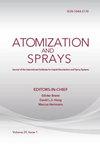泡腾雾化的实验研究:第一部分:平端与流线型曝气体设计的比较
IF 0.9
4区 工程技术
Q4 ENGINEERING, CHEMICAL
引用次数: 0
摘要
目前的实验工作是关于泡腾雾化的研究,这是一种两相气液喷雾产生技术,比传统的雾化器有许多优点。本文的研究表明,在由内到外的泡腾式雾化器内部,流线型增气器设计相对于平端增气器设计在增气器尾迹形成气穴方面的优势。实验采用高速投影可视化技术进行。在传统的平端型曝气器设计中,由于不希望形成气穴,导致喷雾具有不稳定性,导致喷雾性能波动。气体空隙的存在也阻止了泡腾式雾化器内部气泡流动的形成,泡腾式雾化器实际上是这些类型雾化器的首选,以实现稳定的喷雾生成和精细的雾化。发现气穴的形成和存在是曝气器钝体再循环和气相浮力作用的结果。评估了四种不同的流线型增气器设计,其尖端为圆弧形状,圆弧/圆弧混合形状,圆弧和DARPA SUBOFF后体设计(在传统船舶设计中很常见),以确定其中最适合减少气泡雾化器内部不必要的气体空隙的设计。这些都是根据在相对较大的工作范围内产生气泡流的能力和给予最小尾迹(曝气体)效应的能力来评估的。经过仔细的实验观察,得出结论,DARPA SUBOFF后体设计是流线型增气器设计中最好的。本文章由计算机程序翻译,如有差异,请以英文原文为准。
Experimental investigation of effervescent atomization: Part I. Comparison of flat-end and streamlined aerator body designs
The present experimental work is concerned with the study of effervescent atomisation, a two-phase gas-liquid spray generation technique that offers many advantages over conventional atomisers. This study shows the advantage of streamlined aerator design over flat-end aerator type with respect to formation of gas void in the aerator wake in the interior of an inside-out type of effervescent atomizer. The experiments are performed employing high-speed shadowgraphy visualizations. It is observed that in the conventional flat-end type of aerator design the formation of gas void is undesirable and leads to spray characterized by instabilities, causing fluctuating spray properties. The existence of gas void also prevents the formation of bubbly flow inside the effervescent atomizer which is actually preferred in these types of atomizers to enable stable spray generation and fine atomization. The formation and existence of gas void is found to be a result of aerator bluff body recirculation and gas phase buoyancy effects. Four different streamlined aerator designs with tips in the shape of circular arc, circular arc/conical hybrid, conical and DARPA SUBOFF afterbody design (which is common in the conventional ship designs) are evaluated to determine the best among them with respect to mitigating the unwanted gas-void in the interior of an effervescent atomizer. These are evaluated with respect to ability to produce bubbly flow over comparatively large operating range and the ability to impart minimum wake (of aerator body) effect. It is concluded, upon careful experimental observations, that DARPA SUBOFF afterbody design is the best among the streamlined aerator designs.
求助全文
通过发布文献求助,成功后即可免费获取论文全文。
去求助
来源期刊

Atomization and Sprays
工程技术-材料科学:综合
CiteScore
2.10
自引率
16.70%
发文量
54
审稿时长
1.7 months
期刊介绍:
The application and utilization of sprays is not new, and in modern society, it is extensive enough that almost every industry and household uses some form of sprays. What is new is an increasing scientific interest in atomization - the need to understand the physical structure of liquids under conditions of higher shear rates and interaction with gaseous flow. This need is being met with the publication of Atomization and Sprays, an authoritative, international journal presenting high quality research, applications, and review papers.
 求助内容:
求助内容: 应助结果提醒方式:
应助结果提醒方式:


